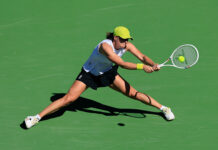Bill Simons
Paris
The miracle man ran out of miracles.
We were amazed that within 43 hours Novak Djokovic scored two astonishing back-to-back comebacks that took him over nine grueling hours.
But then one of the most resilient sportsmen on this planet ran out of magic. After an MRI today, he learned he had a meniscus tear in his right knee that led to his shock withdrawal.
The stunning development prompted many questions.
• Why aren’t officials more proactive in taking care of players? (Jeez, Novak is only the No. 1 player in the world.) Yesterday he pleaded repeatedly with the supervisor to allow the court to be swept more frequently so there would be more clay on the surface and the players would be protected.
• What’s up with all the bad luck at this year’s French Open? Rafa had to face No. 4 Alexander Zverev in the first round. The vastly appealing Naomi Osaki went down to Iga Swiatek in the second round. The weather has been absolutely wretched. And now the GOAT has been hobbled.
• Long ago, Novak had a history of withdrawals. But through much of his career he’s been relatively injury free. Now he joins the three other leading members of tennis’ greatest generation – Nadal, Roger Federer and Andy Murray, who’ve suffered late career injuries.
• Yesterday, Djokovic barked at the supervisor, “You screwed my knee!” Will this prove to be the quote of the tourney?
• Will Novak’s knee just call for a simple procedure, or something more? Will he be able to play Wimbledon or the Paris Olympics, where he so much wants to win gold?
• There’s a long history of meniscus tears in tennis. At the 2021 French Open, young Taylor Fritz felt a pop in his knee. He left the court in a wheelchair and soon had surgery. His young body healed fast and he managed to play Wimbledon three weeks later. In 2016, Federer had some of his meniscus removed, and his subsequent battles with his knee were key to his retirement. But Djokovic has a super body, so this injury won’t end his career – right?
• In hindsight, once Djokovic got hurt early in the second set of his fourth-round match, if he had known he was seriously injured, would he have chosen to retire and not take the maximum dose of pain killers that allowed him to play on for hours on his damaged knee?
• Casper Ruud, the two-time French Open finalist, now is through to the semis and will have four days of rest until he plays on Friday against a fellow named Alex – either German Zverev or Aussie De Minaur. Ruud, who downed Taylor Fritz in four sets in the fourth round, has been playing great tennis. But would he have been able to bring Nole down if the Serb hadn’t withdrawn?
• Djokovic has won 98 titles and is approaching Jimmy Connors’s long-standing record of 109 titles. At the beginning of the year, who would have imagined that Novak would not have won a tourney or even reached a final yet this season?
• Jannik Sinner got a rousing ovation when the crowd was told that, with Djokovic’s withdrawal, Monday he would become the first ever Italian to be No. 1 in the world. Authorities in Italy have done a great job at promoting the game. Before Sinner’s rise, Andriano Panatta, who reached No. 4, was the highest ranking Italian ever. BTW: The ATP Championships are now held in Turin, Italian Andrea Gaudenzi heads the ATP and Jasmine Paolini will play Elena Rybakina in Wednesday’s quarterfinals. All this brings us to the questions: how long will Jannik reign as No. 1 and will Nole ever return to the top?
• Sinner’s coach, Darren Cahill, has worked with other No. 1s, including Lleyton Hewitt, Andre Agassi and Simona Halep. Where do we place him in the pantheon of great tennis coaches?
• We thought the key Djokovic question of the tourney would be what exactly was in that Pandora’s box of private problems he was dealing with. Who knew that an injury would change everything?
GLASS HALF FULL OR HALF EMPTY? You may say that Novak’s withdrawal takes away a certain luster from the tourney. Then again, it does open the door for new faces. Roland Garros will have a first-time champion this year.
WHAT’S WRONG WITH THIS PICTURE? There were 10 night sessions at this year’s French Open. All of them were men’s matches.
TIME FOR A RETHINK: Yesterday Christopher Clarey tweeted, “It’s after 9 pm in Paris and the “day session” just ended. They had nearly two hours of dead time on Center Court after both women’s fourth-round matches ended in straight sets. Now, with Zverev and Rune, they could have another late, late night. Time for a rethink.”
COCO MARCHES ON: What 20-year-old in the world has had a more vast array of experiences than Coco Gauff? She had a stunning out-of-nowhere Wimbledon debut at 15. There were sobs in Serena’s arms in front of thousands at the US Open. A speech on racism she gave in Florida spoke of history and wisdom. She reached the 2022 French Open final and scored a marquee, coming-of-age US Open win in New York. Plus, she’s had a slew of photo shoots and appearances on covers of magazines like Time and Vogue, not to mention plenty of late-night tears as she tried privately to deal with the wounds the tour inevitably delivers.
This year, dozens of American players came here to Roland Garros. But, once again, Coco is the last American standing in a Grand Slam tourney. Playing in her fourth consecutive Roland Garros quarterfinal, she faced the three-time Slam finalist, Ons Jabeur.
But right away, Gauff faltered. On the opening point she hit a double fault. Red Tunisian flags flew, but Gauff’s backers the miscue as a red flag. Soon Jabeur flashed the stunning, asymmetrical variety of her singular game. She unleashed her forehand, hit deep, and created angles, spinny slices, leaping backhands and, of course, clever drop shots. She absolutely dominated on her not-that-fast, but highly effective serve. Gauff couldn’t get a single break point and Ons marched to a first set, 6-4 win.
But Coco is No. 4 in the world for a reason. For starters, noted Jason Goodall, “The one thing you have to love about Coco is her love of the process – to win every single time.”
Once a star in waiting, she now has calm and confidence. She had a 4-2 winning record against Ons and demolished her the last time they played. Plus, Jabeur has had a problematic year. At one point she endured a five-match losing streak. This season she barely has a winning record.
As Gauff called on her athleticism and upped her game, Ons’s serve and energy dipped. Her errors soared, her dropshot winners dropped out of sight, and, when a leaping Jabeur backhand sailed wide, Gauff leapt to a 4-2 third-set lead. Yes, it took her three match points to secure her 4-6, 6-2, 6-3 win. But she was elated.
There was only one problem. For three straight years here, Coco has lost to the eventual French Open champion – and it might happen again. Coco will play Iga Swiatek, who tattooed the well-tattooed No. 5 seed and defending Wimbledon champion, Marketa Vondrousova. The confident and relaxed Pole who won in Madrid and Rome and survived her battle against Osaka, is again back to her bagel-friendly ways – and she has a 4-0 record over Coco on clay, and 10-1 overall.
AN UPDATE FROM THE BAKERY: According to the Athletic, 40.6% of the sets that Iga Swiatek has played have ended up with a 6-0 or 6-1 score.
HOW ABOUT THIS FOR A LONG SHOT: Gauff, Russian Mirra Andreeva and Jasmine Piolini are all still in the singles and doubles draws. So could one of them possibly win both titles.
THE MOST DISSECTED SHOT IN TENNIS: It’s said that Serena used to have the best serve in the history of women’s tennis, and that these days, Elena Rybakina has the best WTA serve. Now that Aryna Sabalenka has her serve under control, there’s much focus on Coco Gauff’s serve. It’s dissected more than any other stroke in the game.
Last year she got a tutorial from Andy Roddick. The other day Coco watchers were delighted Gauff came out and won 23 of her first 24 service points. Coco herself said she has to stick to the changes she has made. She confided, “I have to be uncomfortable.” Then she added, “I tend to go down on my left side on my serve, which causes a lot of double faults. So I think just trying to keep that left side up and just adjusting how I toss the ball, those are the two main things.”
Also reporting: Vinay Ventakesh



















